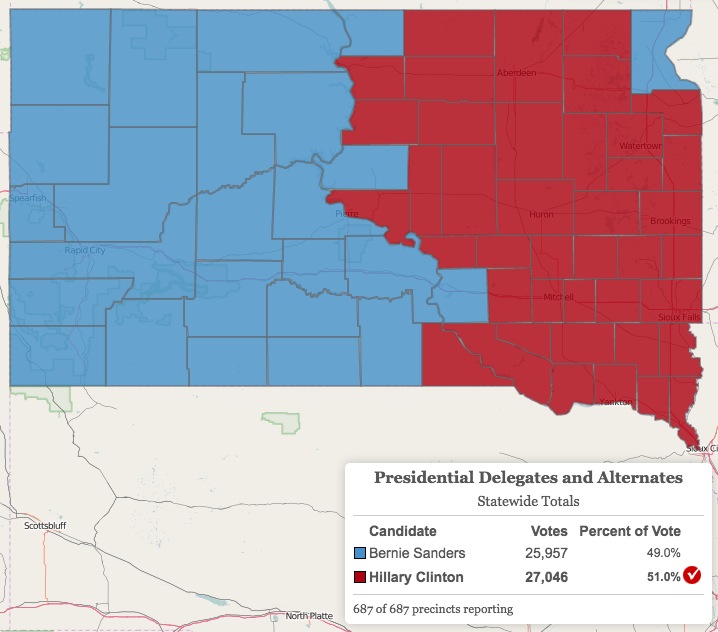Nate Silver of FiveThirtyEight noticed that Hillary Clinton’s win in South Dakota’s primary mildly defied the general assumption that Bernie Sanders played best in white, rural states with open primaries:
…South Dakota is a predominantly white state that allows independents to vote in its primaries — similar to the states that have gone for Sanders.
Our demographic model had Sanders favored in South Dakota — although, note, it had Obama favored in South Dakota in 2008, so maybe there’s something about the demographics there that are hard to pick up.
One factor could be the Native American population, which is about 9 percent of the state’s population. But that doesn’t seem like a likely reason. Sanders is running well in counties that overlap with Native American reservations. And Sanders won Oklahoma, which also has a large Native American vote [Nate Silver, “What Is It About Clinton and South Dakota?” FiveThirtyEight.com, 2016.06.07].
Sanders did do a little better in counties with higher Indian and lower white populations. However, a glance at the map shows that the more prominent Sanders predictor is plain geography:

Sanders won West River; Clinton won most of East River. Among the four East River counties that went for Sanders, Roberts is 35.8% Indian. Brule is 9.3% Indian, just a bit higher than the statewide rate of 8.9%. But Sully and Campbell are 1.7% and 0.5% Indian, respectively.
East River reservation counties Buffalo and Moody went more strongly for Clinton than the statewide average; Charles Mix, which is nearly one-third Indian, gave Clinton just a hair larger percentage than her statewide take.
Oglala Lakota County, the most Indian county in South Dakota at 93% Indian, gave Sanders 58% of its vote. Ten West River counties went even more strongly for Sanders. Of the seven counties where Sanders broke 60%, five are less than 4% Indian. Harding County gave Sanders his highest tally, 74%, and is only 1.8% Indian.
The correlation between the Sanders vote and Indian population by county in South Dakota is 0.29, meaning it’s there but it’s weak. The correlation between the Sanders vote and Indian population by state is similarly tenuous, 0.27. I find a stronger (though also far from “bet the farm”) correlation, 0.42, between the Sanders vote by South Dakota county and the Trump vote. There was no statistically significant correlation between the Republican results by county and Indian population.
Nationally, one may question the “Bernie wins only white, rural states” hypothesis. He won diverse and urbanized states like Hawaii and Washington. Wisconsin showed mixed results by racial category for Sanders and Clinton. Comparing white population by state with Democratic primary and caucus results (a shaky comparison, of course, since folks who show up to vote, especially among caucusgoers, don’t necessarily reflect general demographics) produces a 0.38 correlation, positive but not impressive, between white population by state and Sanders primary tallies.
These figures suggest that frustration with the same same old same-old may be a stronger factor among the South Dakota electorate than the racial vote associations weakly predicted by national trends in the Democratic primary. But in South Dakota’s Democratic primary, that frustration manifested itself less in votes for Bernie Sanders and more in Democrats and Independents not participating.
Participation was dulled by the media announcement that she had already won, kind of makes it a question of why participate. The republicans, on the other hand, did not seem to care that Trump had already beaten the bejabbers out of all comers, and voted with the same numbers as those in the democratic primary.
The one thing we had going here is that the votes were counted and burr head Marty did not blather about voter fraud issues. Votes are still being counted in California! Almost a week after the primary, the vote is still not in. When will we accept that we are not really a democracy anymore. We are so far behind the rest of the western world in how we vote it is pathetic. In other countries, they have more parties and yet they are still able to count the friggin vote while we play marbles with rabbit turds. No wonder the proletariat here knows the game is fixed and ripe for fraud.
Voter turnout was low, low, low! only 17% of democrats and 27% of republicans. Maybe there needs to be a stipulation that if less than 50% of the people vote, then it’s not legitimate? If so, then vote in another week or so? I like the mail-in vote procedures in Washington and Oregon. It could work here!
Deanna, is mail service reliable enough to boost voter participation on the reservations? I’ve heard concerns about that issue from commenters.
Jerry, the AP announcement was non-unique: they did the same thing the day of the primary in 2008. But interestingly, South Dakota’s turnout was lower than expected while California’s was higher. Why that difference? Could the AP announcement have had different effects in our two states?
Geography is destiny in South Dakota. I grew up in Sioux Falls, lived in Pierre and Rapid City. I found it really interesting how the local politics shifts from east to west. There are always local elites, but the amount of sway they have in Sioux Falls is much higher than in Rapid City. In Sioux Falls, progressives are often part of the establishment, so they prefer someone who can work on the inside. Everything is a fight for progressives in Rapid, and Democrats there probably gravitate more to a fighter with stronger positions. In Pierre, a government town, you get to know your political opponents as neighbors, so both sides tend to tone down rhetoric, unless its a really critical issue.